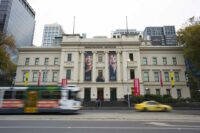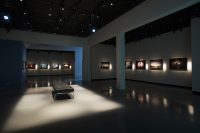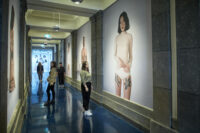
Introducing... the Immigration Museum
12.11.19
The Immigration Museum explores the histories, stories and contemporary issues of Victoria’s diverse communities. We spoke to Rohini Kappadath, the Immigration Museum's General Manager, about how photography is used to share stories about identity and migration.
Does the Immigration Museum have a history of presenting photography exhibitions?
Since opening in 1998, the Immigration Museum has presented several major photography exhibitions including Freedom: The Photography of Andy Drewitt, Leaving Dublin featuring photos by David Monahan and most recently Perseverance: Japanese Tattoo Tradition in a Modern World and Tatau: Marks of Polynesia. Documentary and portraiture photography has also been central to the way we represent and share personal experiences of migration, identity and cultural histories in exhibitions and other experiences.
We recently launched an online collection of original and digital photographs, Muslims in Australia, about the history of Muslim communities across Australia, from earliest arrivals to more recent times. The project crosses time, place, cultures and countries of origin to demonstrate the diversity of people of Muslim faith, their experiences and their contributions to Australian society.
Who is one of the most memorable photographers the Immigration Museum has exhibited?
The Immigration Museum worked with Australian photographer Andy Drewitt in 2015. After being disillusioned by the way asylum seekers were generally only portrayed as people fleeing persecution or conflict, Drewitt wanted to see photos focused on what their freedom looked like once it had been achieved.
So, in an attempt to offer a human face to the debate, he began photographing people who had settled in Australia after being displaced, with a focus on what they do once they have the freedom to choose. The portraits are powerful yet joyful works which portray people who have been through harrowing experiences, now enjoying simple pleasures like playing basketball, listening to music and reading.

Freedom: The Photography of Andy Drewitt. Image courtesy of Museums Victoria.
Why is it significant that PHOTO 2020 is taking place in Melbourne?
Melbourne has an incredibly diverse and engaged community of creative beings and citizens who participate in its arts and cultural scene. If we’re looking to address the major issues of our time through photography, Melbourne offers the perfect setting with world class curatorial expertise, interested thinkers and cultural producers, who bring a multiplicity of perspectives and lived experiences to contribute to ongoing debates about how we will continue to live together in a harmonious and fair society.
Why is the relationship between photography and truth important to investigate in the post-internet age?
We are currently living in a complex social and political climate, where misinformation can make it hard to interpret what is accurate. Words can be very easy to misinterpret, photographs don’t lie. At the same time, the idea of truth in photography is interesting to explore, particularly through the lens of constructing identity, personal representation and the concept of belonging.
Photography allows people to communicate truth in ways that are personal, meaningful and immediate. A great photo can tell a story and move people in ways that words cannot. Though becoming a great photographer requires dedication and practice, anybody who has a camera or an iPhone today has the tools for truth-telling through photography, and the potential to reach global viewership never before imagined.

Our Bodies, Our Voices, Our Marks. Image courtesy of Museums Victoria.
What's the most exciting aspect of being part of Melbourne's first international festival of photography?
The opportunity to offer a local artist a platform at the Immigration Museum, to present and explore migrant narratives, postcolonial practices in the African diaspora and concepts of identity and home.
What can we expect from the Museum during PHOTO 2020?
Melbourne can expect surreal mythologies and constructed unrealities brought to life in brand new work created by a local artist from the African-Australian diaspora. The show will examine what is created in the act of image making, and consider how we construct pictures and stories to understand ourselves, our surroundings and our subjects.
Rohini Kappadath is an entrepreneur and business woman with over 25 years of experience working in Australia and across Asian markets. Previously the Managing Director of SAS Institute India and a director at Pitcher Partners, Rohini was awarded a Telstra Business Woman’s Award in 2015. She is now the general manager at the Immigration Museum.